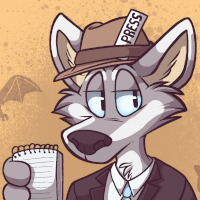Spirit Hunters Book 2: The Open Road, by Paul Kidd – Book Review by Fred Patten
by Pup Matthias
Submitted by Fred Patten, Furry’s favorite historian and reviewer.
 Spirit Hunters. Book 2: The Open Road, by Paul Kidd. Illustrated.
Spirit Hunters. Book 2: The Open Road, by Paul Kidd. Illustrated.
Raleigh, NC, Lulu.com/Perth, Western Australia, Kitsune Press, May 2016, trade paperback $25.84 (395 pages), Kindle $7.99.
Spirit Hunters. Book 1: The Way of the Fox was published in September 2014, and reviewed here in January 2015. It contains the first three Encounters of about a hundred pages each. I said that, “Spirit Hunters is set in the realm of traditional Japanese mythology, vaguely around 900 or 1000 A.D.” The Spirit Hunters are a quartet who wander throughout medieval mythical Japan hunting yokai — supernatural spirits. Lady Kitsune nō Sura, a fox woman, and her companion Tsunetomo Tonbo, a huge human samurai with “a solid iron staff longer than he was tall. The business end was grimly studded with spikes. It was the weapon of a monster slayer – a thing designed to obliterate helmets, armour and anything organic that might get in its way,” are “itinerant Spirit Hunters, traveling throughout Japan looking for evil Spirits to kill – hopefully for pay.” Asodo Kuno is a young bottom-ranking samurai who hopes that killing demons will gain him a reputation and higher status. Chiri is a shy rat-spirit who Sura persuades to join them. She is accompanied by two little spirits of her own: Daitanishi the rock elemental, and Bifuuko the apparent insect; an air elemental.
Sura and Chiri are the main characters who make this a furry book. Sura is described in the first book as:
“A fox woman lounged upon a fallen log like a reclining Buddha, eating a roasted chicken leg. Beside her, there were the embers of a camp fire and a pair of backpacks ready for travel. The fox woman had a long, clever pointed muzzle, and great, green eyes filled with humour. Her body was human in size and shape – excepting for its lush pelt of fur, her fox head with muzzle and long pointed ears, and her long, elegant red tail. She wore a priestess’ robes decorated with images of peaches – with each peach missing a single bite. The fox called out to Kuno in a loud and merry voice while she wriggled her black-furred toes.” (The Way of the Fox, p. 12) She gets the quartet into their adventures, blithely assuring them, “Trust me – I’m a fox!”


 Insect Dreams: The Half Life of Gregor Samsa, by Marc Estrin.
Insect Dreams: The Half Life of Gregor Samsa, by Marc Estrin. Timbuktu; A Novel, by Paul Auster.
Timbuktu; A Novel, by Paul Auster. Special Feature, by Charles V. DeVet.
Special Feature, by Charles V. DeVet. Mouse Mission, by Prudence Breitrose. Illustrated by Stephanie Yue.
Mouse Mission, by Prudence Breitrose. Illustrated by Stephanie Yue. Zen: Meditations d’Un Canard Égoiste (Zen: Meditations of an Egotistical Duck), by Phicil
Zen: Meditations d’Un Canard Égoiste (Zen: Meditations of an Egotistical Duck), by Phicil Simon Thorn and the Wolf’s Den, by Aimée Carter
Simon Thorn and the Wolf’s Den, by Aimée Carter Light: A Tale of the Magical Creatures of Zudukii, by T. S. McNally. Revised First Edition.
Light: A Tale of the Magical Creatures of Zudukii, by T. S. McNally. Revised First Edition. Transmission Lost, by Stefan C. Mazzara.
Transmission Lost, by Stefan C. Mazzara. The Sage of Waterloo: A Tale, by Leona Francombe
The Sage of Waterloo: A Tale, by Leona Francombe